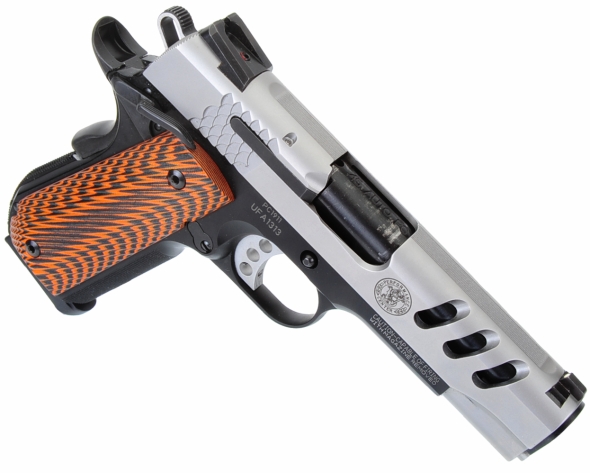
Most of the time, writing is about being a student and class begins when an unfamiliar firearm is placed on the bench. There are manuals and other literature to read, specs and features to discover and understand, disassembly and reassembly to ID parts and associated function, and lots of live fire to objectively measure the success of it all. I stay away from gun forums and Wiki information, which is often conjecture, subjective opinion and, often, well articulated misunderstandings. If I get it wrong, I want it to be on me and not on an anonymous source.
|
Smith & Wesson SW1911PC |
|
| Company | Smith & Wesson |
| Point of Manufacturer | Springfield, MA |
| SKU # | 170344 |
| Type of Action | Short Recoil Tilting Barrel |
| Caliber | 45 Automatic |
| Capacity | 8+1 |
| Barrel Length | 4.25″ |
| Barrel Material | Stainless |
| Rifling Twist Rate | 1:15″ |
| Slide Material | Stainless |
| Slide Finish | Matte Stainless |
| Frame Material | Scandium Alloy |
| Frame Finish | Matte Black |
| Grips | G10 |
| Front Sight | Dot Post |
| Rear Sight | Two Dot Fixed |
| Weight of Firearm | 29.6 Oz |
| Trigger Pull | 3 lbs 12 oz |
| Overall Length | 7.95″ |
| Overall Height | 5.62″ |
| Width | 1.25″ @ Grip |
| Thumb Safety | Ambi Thumb |
| Grip Safety | Yes |
| Magazine Disconnect | No |
| Loaded Chamber Port | Yes |
| Key Lock | No |
| CA Approved | No |
| MA Approved | Yes |
| MD Approved | Yes |
| MSRP | $1,589 |
When you want to build an accurate 1911 type auto, you disassemble it to piece parts, checking all critical dimensions and fit as you go, make modification or replace pieces as required and carefully reassemble and adjust as necessary. As an alternative, you buy a quality pistol, then take it to a reputable pistol smith and have them do the work. Even easier, you buy a SW1911 from the S&W Performance Center and begin with more than the end result of the other efforts.
The SW 1911 has a distinct S&W look, but the “look” carries over to function.
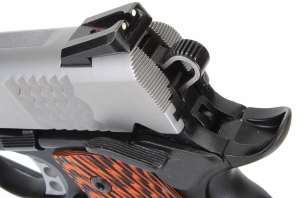
The rear of the slide below the rear sight is striated (not serrated) to eliminate reflected light glare on the rear sight. A striated panel runs the length of the slide between front and rear sights for the same purpose. The hammer striations make for a non-slip surface, the same applies to the ambidextrous safety surfaces. The fish scale like gripping surfaces look very spiffy, but they also provide a directional non-slip surface that comes in handy when pulling against a recoil spring of consequence.
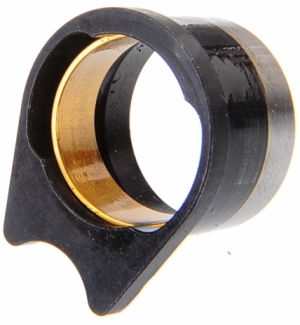
Spherical bushings work. I install them in my 1911. What looks what is normally referred to as a barrel bushing in a 1911, is the bushing housing in this type of set up and they are machined and finished to a close fit with the pistol’s slide. A spherical Titanium bushing is fit to the bushing housing, just enough micro clearance to allow the bushing to rotate freely within the housing.
The inside diameter of the bushing is very closely fit to the barrel, approximately 0.001″ clearance, something that could not be done with a conventional bushing as the barrel would bind as it was tilted down out of battery when the pistol was discharge. With the spherical bushing, as the barrel tips downward, the muzzle and Titanium bushing rotate within the bushing housing so there is no binding.
The barrel lug is milled to just clear the slide stop where the slide is fully closed, the barrel is full up, the radial lugs are engaged, there is no slop felt when pressing down on the barrel through the ejection port, and there is minimal clearance between the barrel hood and slide breech face.

The slide to frame fit is hand lapped and a very close fit. Racking the slide without the recoil spring under tension, the travel is consistent and without too much slack or binding. The slide ported lightning cuts lessen reciprocating mass to reduce recoil and muzzle jump.
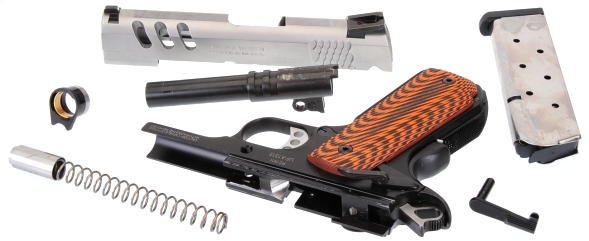
The sear angles and hammer hooks are cut and polished for proper mating by hand to assure a crisp trigger with a pull that falls between 3.5 lbs and 4 lbs. The light trigger minimizes trigger bounce. On the subject gun, pretravel was approx 0.080″ and creep free, the break was clean and there was virtually no over travel. The barrel chamber is hand cut, throated, the entry bevel is hand polished, and the muzzle target crowned.
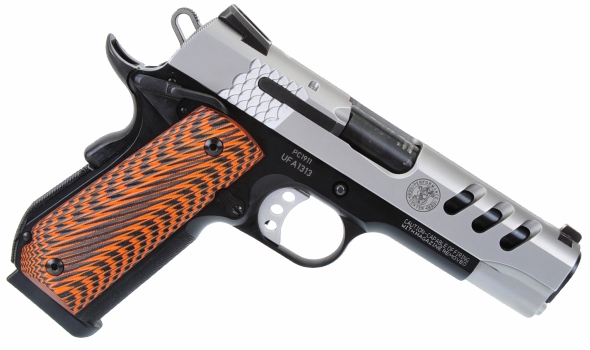
 The extractor is oversize. The ambidextrous thumb safety is extended, its operation positive and it remains out of the way in a two hand hold. The grips, while not may favorite in appearance, are my favorites in shape and gripping surfaces. G10 is a high-pressure thermoset plastic laminate formed from multiple layers of woven fiberglass cloth saturated with an epoxy resin binder.
The extractor is oversize. The ambidextrous thumb safety is extended, its operation positive and it remains out of the way in a two hand hold. The grips, while not may favorite in appearance, are my favorites in shape and gripping surfaces. G10 is a high-pressure thermoset plastic laminate formed from multiple layers of woven fiberglass cloth saturated with an epoxy resin binder.
Both front and backstrap have 30 lines per inch checkering. The grip safety is has a smooth finish, a compression bump and a wide beavertail that places the hand into a natural high grip.
I like the Scandium aluminum alloy frame. Adding small amounts of Scandium to aluminum significantly strengthens the aluminum, yield and wear characteristics. I know, “But what about a friend of mine who heard gunsmith say that he has a customer with twenty Scandium framed guns and they all blew up using extra low pressure ammo!!…!. Yes, sarcasm. Never had a problem with Scandium, but then I shoot factory ammo that meets SAAMI/CIP specification and I am a careful handloader. Additionally, the SW1911PC is backed by the Smith & Wesson life time service policy.
I think this about wraps up our little familiarization coverage. Suitable ammunition will be collected, we will burn up a sizeable amount with the Smith and Wesson SW1911PC and make notes on whatever transpires.
Smith & Wesson SW1911PC Part 1
Smith & Wesson SW1911PC Part 2

Email Notification